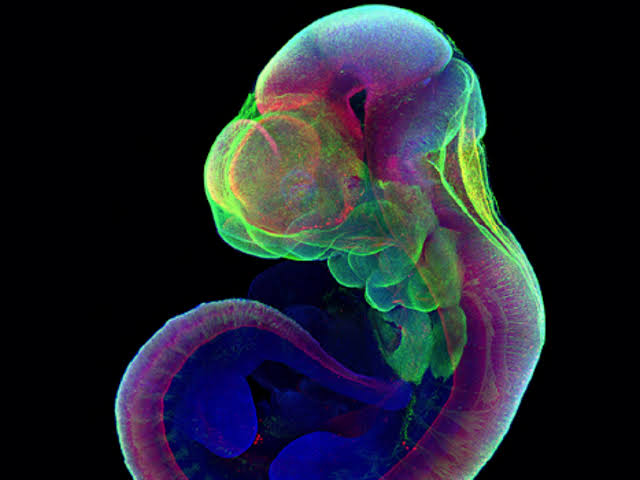The questions that scientists have to weigh as they navigate the ethics of fast-moving stem cell research can sometimes sound like science fiction.
Embryo-like structures concocted in a lab from skin tissue can help researchers peer into the “black box” of early human development.
Meanwhile, new frontiers in transplant and disease research could be opened by studies that introduce human cells into animals, or those creating tissue from stem cells that mimics organs, like kidneys and even brains.
But how far should this go? Where is the red line not to be crossed?
Guardrails need to adapt to deal with unexpected developments, notes bioethicist Insoo Hyun, who has worked on International Society for Stem Cell Research guidelines since they were first produced in 2006.
“We do not need to come up with guidelines for all of eternity, because we don’t know what’s going to happen,” Hyun, of Case Western Reserve University School of Medicine and the Center for Bioethics Harvard Medical School, told AFP.
For the latest guidelines, released Wednesday, Hyun led a subcommittee of scientists looking at human-animal chimera research and the stem-cell derived “organoids”.
“We want to let the field breathe and develop and explore. But we have to be ready to respond to trends that might need some attention,” he said.
AFP talked to Hyun just before the new guidelines were published.
– How do the guidelines work? –
“I use the metaphor of a three-light system; green, yellow, red.
“Green light is no problem, just tell us that you’re doing that. Yellow, we need to assess it. Then the red light is do not do this at this time — like human reproductive cloning or the transfer of CRISPR gene-edited embryos into the uterus.
“Research should have societal or humanitarian benefit, and by that we can also mean expanding scientific knowledge. If it lacks that, then it is a non-starter.
“So for example, what if scientists want to make a monkey-human hybrid? That would be a 50/50 split in DNA, uniting a sperm and egg of two different species. There’s no scientific question you would answer by doing that experiment. So that’s a non-starter.
“A lot of scientists seem to think that bioethics get in the way of science. But I think we help pave the way. If you don’t have traffic lights, you get traffic jams and you get accidents.”
– Why guidelines instead of laws? –
“In most places internationally, there is no legislation.
“We are the next best thing and although there is nothing we can do to penalise anybody for violating the guidelines, they are influential, people do adopt them.
“The problem with legislation is it’s very slow and cumbersome.
“In a rapidly-moving area like stem-cell science or gene-editing work, the guidelines almost need to be a living document, constantly evolving alongside the science.
“That’s not to say that ethics is completely relative. We can still have these general broad ethical principles that everyone understands.”
– What concerns do people have about the research? –
“People sometimes worry about where science is going to take us as a society in the future, whether it’s with CRISPR or whatever. That’s a completely understandable concern.
“But there is no master conductor for science saying, ‘we are all going in this direction or that direction’.
“It’s all fragmented. People work on their projects and then these intersect in unexpected ways.
“What if somebody goes rogue? This research is so technologically difficult, very few people can pull it off, so I can’t imagine someone in their garage doing this.
“That’s a reality check that makes me feel less fearful about some of these scenarios.”
– What has changed since the last update? –
“Brain organoid research and chimeric embryo work were not really big things in 2016.
“Embryo modelling (creating embryo-like structures using modified tissue, like skin cells) is also a major area that was barely starting.
“The original roots of the word clone is from the Greek word ‘klon’, which means twig. It comes from horticulture — when you take a twig from a geranium and make a new plant, that was a clone.
“These are true cloned embryos, in the sense that all the mitochondrial DNA is completely genetically identical.
“A lot rides on whether or not they are developmentally competent, or thought to be — you can’t do the experiment to answer that question definitively for humans, you have to infer from animal data.
“But if you made embryo models from monkey skin and ever got live monkeys born, that would change the conversation for human models.
“We are moving more and more away from defining an embryo based on how it was made and towards what it can do if you put it into the womb. What can it become?”
– What research will you be watching out for in the coming years? –
“I will be interested to see where organoid research goes. I think we’re far away from brain organoids on their own causing problems, but if you start pairing them with other organoid systems to make this quasi-integrated thing. That’s something to keep an eye on.
“Another area — although I don’t think it’s moving that quickly — is stem-cell derived sperm and eggs.
“If you can go from the skin cell (the stem cell line) to a functioning developmentally competent sperm or egg that could be really interesting.
“People are really worried about genome editing to make babies. I think that if that were to ever happen it would come from the work done on these artificial gametes.”
– Is there anything that you wonder ‘why hasn’t anyone done that yet’? –
“I hesitate to tell people because I don’t want somebody to do it!
“There is one idea that I’m not afraid to tell people — species rescue. I think that’s a really exciting possibility.
“We have tissue samples stored from a lot of species, like frozen zoos.
“The old idea was to take an egg from a related species and do it like the Dolly technique (the sheep cloned by fusing DNA from an adult sheep cell into a recipient egg), but that’s very unreliable. You would have an elephant egg and mammoth nucleus. We don’t know if that would even work.
“But if you could make embryo models that are developmentally competent from tissue samples then you could gestate that.
“Maybe we can actually go back to the frozen Ark and get these things back, like making up for your past sins of extinction.”





